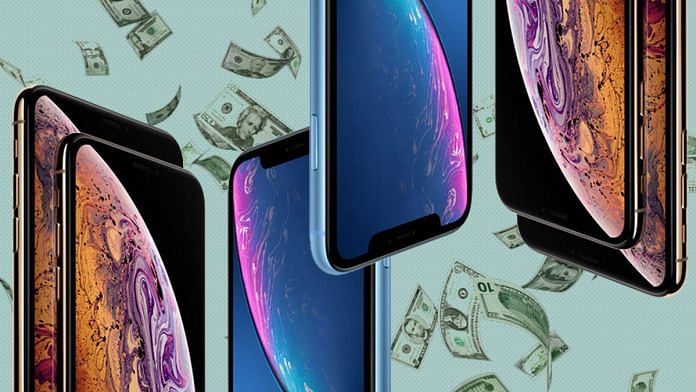Apple recently launched its new iPhone X series, which starts from Rs 76,900 and go over a lakh. The company reduced the price of some of its older iPhones while discontinuing many others.
ThePrint asks– iPhone gets bigger and costlier: Can the Indian wallet keep up?
Apple either underestimates Indian tech acumen or overestimates its own value
 Diksha Madhok
Diksha Madhok
Digital director
For the past couple of years, analysts have been predicting that India could be Apple’s next China. Apple’s CEO Tim Cook has said that his company is putting a “lot of energy” into India, which is the world’s third largest smartphone market. Despite these rosy predictions and promises, the phone-maker has a paltry 2 per cent market share in a country dominated by Chinese and Korean players.
The biggest reason behind its low sales in India is the Apple price tags. In a country where the average price of a smartphone is around $150, Apple’s new phones cost more than $1,400.
But herein lies another big problem for the Cupertino-based tech giant. It cannot really reduce the prices of its new products drastically if it wants to retain the aspirational value of its phones, something people would give anything for. The company would simply have to become a lot more creative to fit more Indian wallets. For example, it needs to partner with local companies to offer financing options such as cash back rewards and EMIs.
It also needs to slash the prices of its older models considerably. Right now, it is selling its iPhone 6S, a three-year-old model, for nearly Rs 30,000. It seems Apple either severely underestimates the technical acumen of Indians or grossly overestimates its own aspirational value.
In the meantime, if you really want an unaffordable iPhone, worry not: There is an Indian startup which lets you rent the iPhone X for just Rs 4,000 a month.
Apple is the forbidden fruit, will always have buyers
 Deeksha Bhardwaj
Deeksha Bhardwaj
Journalist
For the record, Apple never wanted to create a mass-market product. At the very outset, Apple established itself as a brand and a lifestyle choice.
The first iPhone was launched at a price that was way higher than most of its competitors in 2007. The import of the phone to India, despite a relatively favourable exchange rate, was tedious with numerous customs and import duties.
If you think about it, considering inflation and purchasing power parity, the iPhone 4S was costlier than the iPhone 6.
Now, nearly 10 years later, iPhone has made nearly a $250 jump, with the latest XR priced at $749 in the US.
On the other hand, the depreciating Rupee has added to the woes of its users. Today $1 equals Rs 72. The exchange rate hits the iPhone price that has stayed relatively stable over the last four years.
Moreover, the smartphone market has adapted to subsequent generations. As smartphones get cheaper, iPhones get more expensive.
However, let’s not forget, most people don’t buy an iPhone for its use-value, but for the brand Apple represents. Owning an iPhone initially was seen as a “status symbol”, but as the market for the product expands, it has come to define an allegiance for the users of the iOS (Apple’s operating system).
Apple will always have buyers. Proof of this is the most recent report that shows that despite a dip in sales, revenues are higher.
For those seeking a reasonable option, the smartphone market, especially with the entry of OnePlus, offers similar products – but without a bite of the forbidden fruit.
As long as Apple continues to be sinful, there will always be a niche audience that will flock to it.
Apple is struggling in the second highest-populated market
 Mahua Venkatesh
Mahua Venkatesh
Associate editor
For the urban middle class in India, owning an iPhone is a matter of aspiration much like owning a BMW or a Mercedes. It accords a status. In fact, Warren Buffett recently said in an interview that the iPhone X was underpriced!
But despite a healthy growth in smartphone user-base and rising aspiration level of Indian consumers, Apple, the maker of iPhone, is struggling in the second highest populated market. As it keeps launching new phones that are getting more and more expensive, Android phones manufactured by Korean major Samsung and other Chinese dragons continue to dominate the Indian market.
Samsung has also managed to balance aspiration and price—and that is denting the iPhone market here. China’s OnePlus has also begun to make its mark.
The signs are clear— the days of standing in a queue to grab the new iPhone are becoming a thing of the past.
iPhone loyalists, of course, continue to stick with the company notwithstanding the aggressively high priced phones. But many others either resort to fake iPhones available at much cheaper prices or switch to other brands. Also, many feel that an Android is best suited to Indian conditions.
Apple’s policy of constantly flooding the market with new phones with different and superior features has left many customers, especially the young and mid-level executives—who go all out to possess an iPhone, many a time on an EMI—unhappy. Now, even before the EMI is serviced, you have a new phone in the market, which often leaves the price-sensitive Indian customer wondering.
The number of smartphone users, which is on a steady rise, is expected to be over 330 million by this year-end. According to a study, India registered an 18 per cent growth in the smartphone segment in the first quarter of the current financial year compared to the same period last year. But despite the encouraging data, Apple will find it tough to crack this price sensitive market.
The Indian wallet has seldom gone for the latest version of the iPhone
 Yashasvini Mathur
Yashasvini Mathur
Journalist
On 11 September 2018 everyone who could distinguish between a turbocharger and a type-C charger was waiting for the event of the year — the Apple launch. Sadly for all, they launched a phone that costs a lakh.
Why would anyone spend a lakh to buy a phone that looks almost identical to its older siblings, and has no major upgrades apart from the fact that it can now support two SIM cards— which, to be honest, is not impressive, interesting or even necessary.
iPhone prices in India are an average 31 per cent higher than the US already, which may be a reason why its sales are slowing dwindling in the country. However, one must realise that the popularity of iPhones, and the price tag associated with the latest versions are two separate things. The Indian wallet has seldom gone for the latest version of the iPhone. People buy the older versions of iPhones much after the newest version is out. They get to be a part of the family, and yet have to shell out a lot less, and perhaps can even avail a discount.
There is now a large segment of the finance market offering deals and EMI services for iPhones. Reports suggest that most iPhones are bought on EMIs to make them more affordable, even though they end-up costing more in the long run.
The debate is not if an Indian wallet can keep up — we are masters of jugaad and there is no way that we won’t find a way to get what we want. The truth is that iPhone’s success or failure is not dependent on its price, but on how long the brand can keep its customers engaged. The sales of the new iPhones will have an impact on the valuation of the company, but not their revenue. Apple’s true test will start in the coming months when the more affordable and popular iPhone 6S and iPhone SE are phased out. Who then, will bite the Apple?
By Neera Majumdar, journalist at ThePrint.




Apoorvanad is a teacher at Delhi university and he tries his Best to propagate anti-Hindu thoughts among the young minds. All this while he draws a salary of Rs 2 lakhs from the government coffers that in turn gets 90% revenue from Hindus.